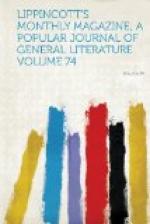The variety of vegetable productions is so great that above five thousand species, more than half of which are peculiar to the country, have been described and classed. Among the most remarkable is the species of Eucalyptus, or gum tree, that forms some of the largest timber yet discovered, having been seen of the height of one hundred and fifty feet, and thirty to forty in girth near the root. The leafless acacias are also found here, as well as the Nepenthes distillatoria and the Cephalotus follicularis, two remarkable varieties of the monkey-cup or pitcher-plant; while many very beautiful ferns and flowering vines adorn the coasts and lave their graceful fringes in the blue ocean waves. The timber of the country is of gigantic size, and with other varieties may be found cedar, rosewood, tulip and mahogany.
But the most wonderful products of Australia belong to the animal kingdom, among them the kangaroo, the wombat, and that strange anomaly of the animal creation, the Ornithorynchus, or “duck-billed quadruped.” Emus, eagles, parrots, white swans and overgrown pelicans of many varieties, enrich the ornithological kingdom, while among insects and reptiles are found some less desirable specimens, such as tarantulas. The natives of the island hold the old tradition of the ancients, that one bitten by a tarantula will dance himself to death. The plumage of Australian birds is varied and brilliant, and the natives make pretty fans by arranging the feathers in assorted colors; while a sort of head-dress worn by both men and women on the occasion of their marriage, and composed entirely of feathers made into many-tinted flowers, is a very gorgeous affair. Among the varieties of birds peculiar to the island are the “lyre-bird” and that known as the “satin-bower,” so called from its glossy plumage, which is green while the bird is young and jet black at maturity. Before building their nests these birds gather a large quantity of twigs, weaving them into a sort of bower, which they tastefully decorate with bones, feathers, leaves and such other adornments as they are able to collect. Here in this arena the courting is done, the male bird chasing his mate up and down, bowing his pretty head and playing the agreeable generally, while she indulges in all manner of airs and graces, pretends to be very coy, and acts the coquette to perfection. But her lover’s devotion conquers at last, and in due time the fair flirt surrenders, yields up her liberty and settles down as a dutiful wife and loving mother, bringing up a family of sons and daughters, and no doubt duly instructing them in the part they in their turn are to take in life’s drama. The black swans are not prettier than white ones, but they are rarer, and when both are floating together over the smooth surface of those lovely Australian lakes they present a picture of which one never wearies, see it as often as one may.
[Illustration: FOREST OF FERNS.]




